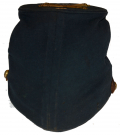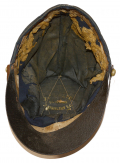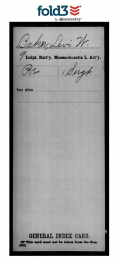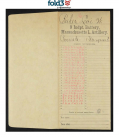site search
online catalog
NINTH MASSACHUSETTS ARTILLERY " GETTYSBURG RETREAT BY RECOIL" CAP

$9,650.00 SOLD
Quantity Available: None
Item Code: 1284-01
This forage cap of the "McDowell" style was picked up immediately following the Battle of Gettysburg and subsequently resided in a Massachusetts GAR hall for over 60 years. Its importance cannot be overestimated!
The private purchase McDowell forage cap was made by Abe Lincoln's hatmaker! The hat of dark blue broadcloth has a virtually perfect exterior. The height in front is 5 inches. The diameter of the crown is 5 1/2 inches. The stiff Patent leather thick peak or bill is of the McDowell type and measures 2 inches in depth and is 12 1/2 inches end to end. The original Patent leather chinstrap with its stamped brass buckle is held in place by 2 circa 1858-61 "Mass. Volunteer Militia" staff buttons which were sewn to the cap when originally assembled. On the crown of the cap are crossed brass cannons surmounted by a brass "9" and below the cannons is a fancy silver serifed capitol "M". Signifying 9th Artillery Massachusetts. These devices are unmolested and applied at the time the cap was made. The interior has embossed in the crown in gold letters is: " JAS. Y. DAVIS 356 PENN. AVENUE WASHINGTON D.C." (Davis was doing business as early as 1858 at this address, his caps were of the finest quality made for both officers and enlisted personnel. We refer you to North South Trader's Civil War Magazine Vol. 43. No.3 / 2023. Pages 22 to 37). The interior crown and the entire interior are covered in a silk blend black cloth. This is 70% intact and sits over a padding of raw cotton at its rear portion characteristic of finer made hats. The lining fabric shows wear and use. Portions of it have been professionally reenforced to prevent further loss (2023). Because this cap sat on the ground from July 2nd to perhaps the 7th the original sweat band was compromised and is now missing. Exposed is the cardboard base circumference stiffener which has been stabilized (2023) and new sections added in a couple of spots as it too, like the sweat band was affected by ground action and the weather. The size of the cap is about 7 1/4.
The following is a history of the 9th Massachusetts Battery up to and including its heroic action at Gettysburg. They afterwards were active until the surrender of Lee's army at Appomattox, but we are concerned here only with their service up to and including Gettysburg because this cap's use is specific to that time. Here is their history:
"August 10, 1862, organized at Camp Meigs, Readville, and mustered on September 3 and left Massachusetts for Washington, D.C. and attached to Abercrombie's Division, Military Division, Military District of Washington DC for duty in the Defenses of Washington. September 7 at Camp Seymour, Capitol Hill. September 23 at Camp Chase. October 27 at Camp Barry. November 19 at Forts Ramsey and Buffalo, Upton’s Hill, Va. February. Moved to Centreville, Va May Attached to Barry's Command 22nd Corps. June 25 to Fairfax Court House and Edward’s Ferry June 27 To Frederick City, Maryland. June 29 to Middleburg June 30 to Tanneytown. From here immediately to Gettysburg Pa and attached to 1st Volunteer Brigade, Reserve Corps, Army of the Potomac.
On July 2nd as Federals of the III and V Corps retreated from the Emmitsburg Road, the Peach Orchard, and the Wheatfield, the Confederate tide began to sweep towards Cemetery Ridge. A line of gun batteries near the Wheatfield, which had been behind the infantry line, was now exposed to the assault and completely without support. Among them was the 9th Massachusetts Battery commanded by Capt. John Bigelow. This was their first fight. As the other batteries pulled back, the 9th was the last on that part of the field. Their brigade commander, Lt. Col. Freeman McGilvery, rode up to Capt. Bigelow and informed him that they were “alone on the field, without support of any kind…Limber up and get out!” But there wasn’t time to withdraw using horse teams. The 21st Mississippi was almost on top of them. So, the 9th Mass Battery retired by prolong, pulling the guns to the rear even while loading and firing, using the recoil of the cannons to help propel them backwards, blasting cannister into the 21st Mississippi at vicious range.
They reached the Trostle Farm and managed to find enough time to limber up, but McGilvery ordered them to stay in that position and not give ground. The retreat of the III Corps had opened a huge gap in the Federal line and the 9th Mass Battery was desperately needed to help stall the Confederate advance until fresh Union infantry could be brought up. The 9th Mass Battery made a stand against the Barksdale’s Confederates that bought Union commanders half an hour…enough time to bring up elements of the II Corps. By that time, the 9th was flanked on both sides, lost four of their guns, but eventually managed to withdraw."
Here is another fuller account: "When the III Corps units in the Peach Orchard (on the battery’s right) and the V Corps units on Stony Hill (on the battery’s left) eventually gave way and retreated, the 9th Massachusetts Battery found themselves badly exposed. Kershaw’s and Barksdale’s Brigades bore down on them, and the 9th Battery continued to fire into the Confederates’ lines as they paused to reform.
At this point, Lt. Col. McGilvery appeared, telling Bigelow, “[You] are alone on the field, without support of any kind! Limber up and get out!” Noting the proximity of the Confederates, Bigelow replied that he did not have time to limber up but would retire by prolong (pulling the cannons to the rear with men rather than horses). They retired back across the field towards Trostle’s Barn, almost 400 yards away, firing as they went.
Bigelow later wrote, “I say my battery retired by prolonge [sic]. I should perhaps more properly say by the recoil of its guns, for the prolonges were only used to straighten the alignment.” After what must have been a harrowing dash across that field, loading, firing, and pulling the guns as they went, the 9th Battery took up a position in the farmyard adjacent to Trostle’s Barn. Bigelow found they had bought themselves a bit of breathing room, perhaps just enough time to get the guns limbered up and carried to the rear at a gallop. He gave the order to limber up.
Then Lt. Col. McGilvery appeared again and delivered what must have been a sickening order. There was a wide gap now in the Union line. McGilvery, an officer who acted decisively in a key moment, intended to fill part of that gap with reserve artillery batteries. But he needed time to get them deployed. Bigelow’s 9th Massachusetts Battery would buy that time while other batteries formed 500 yards to their rear. “Captain Bigelow,” McGilvery said, “there is not an infantryman back of you along the whole line from which Sickles moved out. You must remain where you are and hold your position at all hazards, and sacrifice your battery, if need be, until at least I can find some batteries to put in position and cover you. The enemy are coming down on you now.”
Preparing to make a stand to the last, Bigelow posted his guns in the farmyard, ordered ammunition piled by each piece and had them load with double canister. It was only moments until the Confederates were virtually on top of them. The regiment that happened to end up directly in their front was the 21st Mississippi of Barksdale’s Brigade. When canister blew huge gaps in their lines, the 21st Mississippi staggered back, reformed and came on again. Then again, and again. The 9th Battery soon ran out of canister and began using shell with the fuses cut short to burst at close range. They expended over three tons of shot and shell, including 92 rounds of canister.
Reid, a correspondent for the Cincinnati Gazette, was close enough to observe the contest between the 21st Mississippi and the 9th Massachusetts Battery. Describing the scene, he wrote: “Reserving his fire a little, then with depressed guns opening with double charges of grape and canister, he smites and shatters, but cannot break the advancing line…On, still onward comes the artillery-defying line, and still [Bigelow] holds his position. They are within six paces of the guns–he fires again. Once more and he blows devoted soldiers from his very muzzles…They spring upon his carriages and shoot down his forces.”
The battery was overrun. Some 80 horses were killed or disabled and 27 men killed or wounded. The remaining men managed to pull two guns to the rear but four were abandoned. Some of the men fought their way to the rear using artillery rammers and sponge rods. Capt. Bigelow was shot twice. The battery’s bugler, Charles Reed, picked the captain up and brought him to the rear, earning Medal of Honor for doing so. Bigelow would survive. The 9th Massachusetts Battery bought about 30 minutes for McGilvery, enough time for him to get his artillery into place. The Mississippians took one more of the batteries before they were done, but eventually they were spent, without support of their own, and retreated.
The next day, the remains of the 9th Massachusetts Battery were posted in Ziegler’s Grove at the base of Cemetery Hill. Lieutenant Richard Milton, the only officer still standing, was now in command. With but two guns, the battery was lightly engaged during Pickett’s Charge. Their third monument on the Gettysburg battlefield in located in Ziegler’s Grove on their final combat position.
In 1885, when the three battlefield monuments of the 9th Massachusetts Battery were dedicated, then 44-year-old Major Bigelow gave an address. He recounted in detail the experiences of the battery at Gettysburg. He stated that the battery had suffered the second highest casualties of any artillery unit in the war. “Yours,” he said, “is a spirited and glorious record, and it is my proudest recollection to have been with you.”
Returning to the forage cap, be aware that the battery prior to the Gettysburg emergency was stationed within the defenses of Washington DC or its immediate environs. It was certainly at this time that the cap was purchased from Davis on Pennsylvania Avenue but by whom? The cap itself tells that tale. Although an enlisted man's hat without the embellishments seen on officer's cap like quatrefoil or a bullion chinstrap this cap is a cut above what one would expect for enlisted personnel. The use of Massachusetts staff buttons bespeaks a staff position. Two ranks in a battery were officially staff positions, the First Sergeant and the Quartermaster Sergeant. The ranking staff NCO aka First Sergeant or Orderly Sergeant worked for, and answered to, the captain only. He carried out all details desired by the captain that pertained to the company, not an individual segment of it. If the battery happened to be short an officer due to leave, sickness, or death, the first sergeant took up the duties of the chief of the line of caissons by direction of the captain. He remained assigned until a replacement was transferred in, or more often, he was elected and/or permanently promoted the junior lieutenant. The Quartermaster Sergeant received his direction from the first sergeant or the captain. He was to keep with the commander and carry out any orders issued him. However, most often he was detailed to remain with the baggage or supply wagons assigned the battery or the parent artillery battalion and see to their safe keeping.
Does this make it possible for one to identify the artilleryman that wore and lost this cap during the destruction of the battery July 2, 1863? We believe it does; the two candidates we put forward are: First Sergeant Levi W. Baker wounded at Gettysburg, or Quarter Master Sergeant James W. Reed. Reed was also wounded at Gettysburg in the neck on July 2, 1863. The identity will remain uncertain but what is certain is that this cap can be from no other unit but the 9th Massachusetts Battery and that it was found in the proximity of the Peach Orchard/Trostle Farm after the struggle.
This historic cap was deposited shortly after the war at Grant Post 4, Melrose Massachusetts (Chartered 1867). It was on display there for decades in a dedicated case of Gettysburg relics. With the cap is a handwritten faded tag that reads "Peach Orchard". We do not claim that the tag is of the Civil War era nor the 19th century. It could have been placed with the cap any time prior to the post losing its charter in 1945. The artifacts from this GAR hall were sold off no later than 1965. Several pieces ended up in collections and some have changed hands recently.
The importance of this treasure to a Gettysburg collection in particular or a Civil War collection in general cannot be overestimated. [pe][ph:L]
~~~~~~~~~~~~~~~~~~~~~~~~~~~~~~~~~~~
THIS ITEM, AS WITH ALL OTHER ITEMS AVAILABLE ON OUR WEB SITE,
MAY BE PURCHASED THROUGH OUR LAYAWAY PROGRAM.
CLICK HERE FOR OUR POLICIES AND TERMS.
THANK YOU!
Inquire About NINTH MASSACHUSETTS ARTILLERY " GETTYSBURG RETREAT BY RECOIL" CAP
For inquiries, please email us at [email protected]
Most Popular
Historical Firearms Stolen From The National Civil War Museum In Harrisburg, Pa »
Theft From Gravesite Of Gen. John Reynolds »
Selection Of Unframed Prints By Don Troiani »
Fine Condition Brass Infantry Bugle Insignia »
British Imported, Confederate Used Bayonet »
Scarce New Model 1865 Sharps Still In Percussion Near Factory New »
featured item
CONFEDERATE CAVALRY CAPTAIN’S FROCK COAT OF CAPT. EDWARD BIRD, “EFFINGHAM HUSSARS,” 2nd BATTALION AND 5th REGIMENT GEORGIA CAVALRY
This rare, identified, Confederate cavalry captain’s frock coat belonged to an officer who served from 1861 though 1865, rising from Captain to Colonel, with extensive action especially in Wheeler’s cavalry corps fighting against Sherman in the… (1179-232). Learn More »
site search
Upcoming Events
May 16 - 18: N-SSA Spring Nationals, Fort Shenandoah, Winchester, VA Learn More »





















